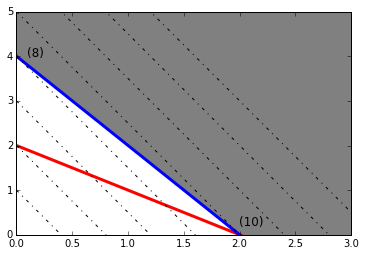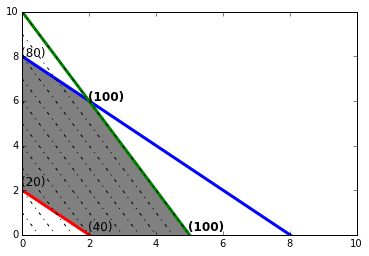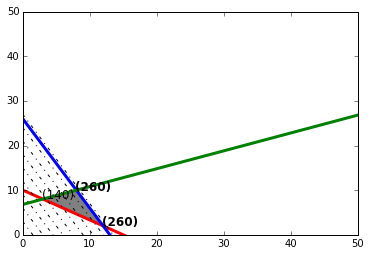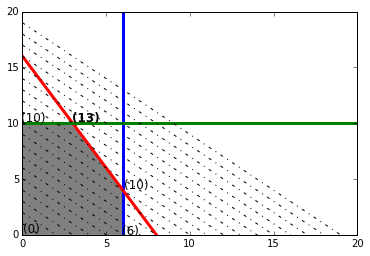01-Simplex-Method
In [2]:
1
2
3
4
5
6
import numpy as np
import pandas as pd
import matplotlib.pyplot as plt
from IPython.display import display
#import mlabwrap
#mlab=mlabwrap.init('/Applications/MATLAB_R2013a.app/bin/matlab')
Introduction to Linear Programming
Question 1 - A
\[\begin{align} \text{Max } P(x; y) = 5x + 2y\\ \text{Subject to}:\\ x + y \geq 2\\ 2x + y \geq 4\\ x; y \geq 0\\ \end{align}\]In [112]:
1
2
3
4
5
6
7
8
9
10
11
12
13
x=np.arange(0,10)
c_1=-1*x+2
c_2=-2*x+4
f=lambda b:(-2.5*x+b)
plt.plot(c_1,'r',linewidth=3)
plt.plot(c_2,'b',linewidth=3)
feasible=np.array([[0,4],[0,5],[5,5],[5,0],[2,0]])
plt.gca().add_patch(plt.Polygon(feasible,color='gray'))
map(lambda b:plt.plot(f(b),'-.k'),xrange(0,9))
plt.text(2,0.2,'(10)',fontsize=12)
plt.text(0.1,4,'(8)',fontsize=12)
plt.xlim(0,3)
_=plt.ylim(0,5)

It is clear from the plot that the Maximization problem is unbounded and the solution to minimization problem is (0,4)
Matlab Linear Programming solution, which corresponds to infinity:
In [12]:
1
2
3
4
f=np.array([-5,-2])
W=np.array([[-1,-1],[-2,-1],[-1,0],[0,-1]])
B=np.array([-2,-4,0,0])
mlab.linprog(f,W,B)
array([ 5.99065774e+21, 2.62912198e+05])
Question 1 - B
\[\begin{align} \text{Min } P(x; y) = 5x + 2y\\ \text{Subject to}:\\ x + y \geq 2\\ 2x + y \geq 4\\ x; y \geq 0\\ \end{align}\]Matlab Linear Programming solution:
In [8]:
1
2
3
4
f=np.array([5,2])
W=np.array([[-1,-1],[-2,-1],[-1,0],[0,-1]])
B=np.array([-2,-4,0,0])
mlab.linprog(f,W,B)
array([ 2.29759394e-08, 3.99999995e+00])
Which we solve by using the dual problem:
In [41]:
1
2
3
A=np.array([[1,1,2],[2,1,4],[5,2,1]])
print 'A=\n',A
print 'A\'=\n',A.T
A=
[[1 1 2]
[2 1 4]
[5 2 1]]
A'=
[[1 2 5]
[1 1 2]
[2 4 1]]
Which corresponds to following problem: \(\begin{align} \text{Max } P(x; y) = 2x + 4y\\ \text{Subject to}:\\ x + 2y \leq 5\\ x + y \leq 2\\ x; y \geq 0\\ \end{align}\)
Writing down the augumented matrix:
In [53]:
1
2
A=np.array([[1,2,1,0,0,5],[1,1,0,1,0,2],[-2,-4,0,0,1,0]])
pd.DataFrame(A,index=['s_1','s_2','P'],columns=['x','y','s_1','s_2','P','b'])
| x | y | s_1 | s_2 | P | b | |
|---|---|---|---|---|---|---|
| s_1 | 1 | 2 | 1 | 0 | 0 | 5 |
| s_2 | 1 | 1 | 0 | 1 | 0 | 2 |
| P | -2 | -4 | 0 | 0 | 1 | 0 |
3 rows × 6 columns
Which has following basic solution: \(\begin{align} x=&0\\ y=&0\\ P=&0\\ s_1=&5\\ s_2=&2\\ \end{align}\)
choosing column $y$ as pivot column and row $s_2$ as pivot row we do the pivot operation:
In [54]:
1
2
3
A[0,:]=A[0,:]-2*A[1,:]
A[2,:]=A[2,:]+4*A[1,:]
pd.DataFrame(A,index=['s_1','y','P'],columns=['x','y','s_1','s_2','P','b'])
| x | y | s_1 | s_2 | P | b | |
|---|---|---|---|---|---|---|
| s_1 | -1 | 0 | 1 | -2 | 0 | 1 |
| y | 1 | 1 | 0 | 1 | 0 | 2 |
| P | 2 | 0 | 0 | 4 | 1 | 8 |
3 rows × 6 columns
This is matrix provides us with the solution: \(\begin{align} x=s_1&=0\\ y=s_2&=4\\ \end{align}\)
Question 2
\[\begin{align} \text{Max } P(x; y) = 20x + 10y\\ \text{Subject to}:\\ x + y \geq 2\\ x + y \leq 8\\ 2x + y \leq 10\\ x; y \geq 0\\ \end{align}\]In [16]:
1
2
3
4
5
6
7
8
9
10
11
12
13
14
15
16
17
18
x=np.arange(0,11)
c_1=-1*x+2
c_2=-1*x+8
c_3=-2*x+10
f=lambda b:(-2*x+b/10.0)
plt.plot(c_1,'r',linewidth=3)
plt.plot(c_2,'b',linewidth=3)
plt.plot(c_3,'g',linewidth=3)
feasible=np.array([[0,2],[0,8],[2,6],[5,0],[2,0]])
plt.gca().add_patch(plt.Polygon(feasible,color='gray'))
map(lambda b:plt.plot(f(b),'-.k'),xrange(0,110,10))
plt.text(0,2.2,'(20)',fontsize=12)
plt.text(0,8,'(80)',fontsize=12)
plt.text(2,6,'(100)',fontsize=12,weight='bold')
plt.text(5,0.2,'(100)',fontsize=12,weight='bold')
plt.text(2,0.2,'(40)',fontsize=12)
plt.xlim(0,10)
_=plt.ylim(0,10)

Matlab Linear Programming solution:
In [17]:
1
2
3
4
f=np.array([-20,-10])
W=np.array([[-1,-1],[1,1],[2,1],[-1,0],[0,-1]])
B=np.array([-2,8,10,0,0])
#mlab.linprog(f,W,B)
In [18]:
1
2
A=np.array([[1,1,-1,0,0,0,2],[1,1,0,1,0,0,8],[2,1,0,0,1,0,10],[20,10,0,0,0,1,0]])
pd.DataFrame(A,index=['s_1','s_2','s_3','P'],columns=['x','y','s_1','s_2','s_3','P','b'])
| x | y | s_1 | s_2 | s_3 | P | b | |
|---|---|---|---|---|---|---|---|
| s_1 | 1 | 1 | -1 | 0 | 0 | 0 | 2 |
| s_2 | 1 | 1 | 0 | 1 | 0 | 0 | 8 |
| s_3 | 2 | 1 | 0 | 0 | 1 | 0 | 10 |
| P | 20 | 10 | 0 | 0 | 0 | 1 | 0 |
4 rows × 7 columns
In [32]:
1
2
3
M=1000
A=np.array([[1,1,-1,0,0,1,0,2],[1,1,0,1,0,0,0,8],[2,1,0,0,1,0,0,10],[-20,-10,0,0,0,M,1,0]])
pd.DataFrame(A,index=['s_1','s_2','s_3','P'],columns=['x','y','s_1','s_2','s_3','a_1','P','b'])
| x | y | s_1 | s_2 | s_3 | a_1 | P | b | |
|---|---|---|---|---|---|---|---|---|
| s_1 | 1 | 1 | -1 | 0 | 0 | 1 | 0 | 2 |
| s_2 | 1 | 1 | 0 | 1 | 0 | 0 | 0 | 8 |
| s_3 | 2 | 1 | 0 | 0 | 1 | 0 | 0 | 10 |
| P | -20 | -10 | 0 | 0 | 0 | 1000 | 1 | 0 |
4 rows × 8 columns
In [33]:
1
2
A[3,:]+=-M*A[0,:]
pd.DataFrame(A,index=['a_1','s_2','s_3','P'],columns=['x','y','s_1','s_2','s_3','a_1','P','b'])
| x | y | s_1 | s_2 | s_3 | a_1 | P | b | |
|---|---|---|---|---|---|---|---|---|
| a_1 | 1 | 1 | -1 | 0 | 0 | 1 | 0 | 2 |
| s_2 | 1 | 1 | 0 | 1 | 0 | 0 | 0 | 8 |
| s_3 | 2 | 1 | 0 | 0 | 1 | 0 | 0 | 10 |
| P | -1020 | -1010 | 1000 | 0 | 0 | 0 | 1 | -2000 |
4 rows × 8 columns
Here we write a simple function to do the pivot operation:
In [25]:
1
2
3
4
5
6
7
8
9
def do_row(A,R,C):
def check(r):
if r!=R:
return True
else:
return False
def row_op(r):
A[r,:]+=-A[r,C]*A[R,:]/A[R,C]
map(row_op,filter(check,xrange(A.shape[0])))
In [34]:
1
A
array([[ 1, 1, -1, 0, 0, 1, 0, 2],
[ 1, 1, 0, 1, 0, 0, 0, 8],
[ 2, 1, 0, 0, 1, 0, 0, 10],
[-1020, -1010, 1000, 0, 0, 0, 1, -2000]])
In [28]:
1
2
3
4
R=0
C=0
do_row(A,R,C)
pd.DataFrame(A,index=['x','s_2','s_3','P'],columns=['x','y','s_1','s_2','s_3','a_1','P','b'])
| x | y | s_1 | s_2 | s_3 | a_1 | P | b | |
|---|---|---|---|---|---|---|---|---|
| x | 1 | 1 | -1 | 0 | 0 | 1 | 0 | 2 |
| s_2 | 0 | 0 | 1 | 1 | 0 | -1 | 0 | 6 |
| s_3 | 0 | -1 | 2 | 0 | 1 | -2 | 0 | 6 |
| P | 0 | 10 | -20 | 0 | 0 | 1020 | 1 | 40 |
4 rows × 8 columns
In [29]:
1
2
3
4
R=2
C=2
do_row(A,R,C)
pd.DataFrame(A,index=['x','s_2','s_1','P'],columns=['x','y','s_1','s_2','s_3','a_1','P','b'])
| x | y | s_1 | s_2 | s_3 | a_1 | P | b | |
|---|---|---|---|---|---|---|---|---|
| x | 1 | 0 | 0 | 0 | 0 | 0 | 0 | 5 |
| s_2 | 0 | 0 | 0 | 1 | -1 | 0 | 0 | 3 |
| s_1 | 0 | -1 | 2 | 0 | 1 | -2 | 0 | 6 |
| P | 0 | 0 | 0 | 0 | 10 | 1000 | 1 | 100 |
4 rows × 8 columns
Since one of the constraint lines is parallel to objective function the whole line segment is optimal. The other end of the line is picked by Matlab solver.
Question 3 - A
In [193]:
1
2
3
4
5
6
7
8
9
%%latex
\begin{align}
\text{Max } P(x; y) =& 20x + 10y\\
\text{Subject to}:&\\
2x + 3y \geq& 30\\
2x + y \leq& 26\\
-2x + 5y \leq& 34\\
x; y \geq& 0\\
\end{align}
\begin{align}
\text{Max } P(x; y) =& 20x + 10y
\text{Subject to}:&
2x + 3y \geq& 30
2x + y \leq& 26
-2x + 5y \leq& 34
x; y \geq& 0
\end{align}
In [254]:
1
2
3
4
5
6
7
8
9
10
11
12
13
14
15
16
17
x=np.arange(0,51)
c_1=-2.0/3*x+30/3
c_2=-2.0*x+26.0
c_3=2.0/5*x+34/5.0
f=lambda b:(-2*x+b/10.0)
plt.plot(c_1,'r',linewidth=3)
plt.plot(c_2,'b',linewidth=3)
plt.plot(c_3,'g',linewidth=3)
feasible=np.array([[3,8],[8,10],[12,2]])
plt.gca().add_patch(plt.Polygon(feasible,color='gray'))
map(lambda b:plt.plot(f(b),'-.k'),xrange(0,300,30))
plt.text(3,8.2,'(140)',fontsize=12)
plt.text(8,10,'(260)',fontsize=12,weight='bold')
plt.text(12,2.2,'(260)',fontsize=12,weight='bold')
plt.xlim(0,50)
_=plt.ylim(0,50)

Matlab Linear Programming solution:
In [16]:
1
2
3
4
f=np.array([-20,-10])
W=np.array([[-2,-3],[2,1],[-2,5],[-1,0],[0,-1]])
B=np.array([-30,26,34,0,0])
mlab.linprog(f,W,B)
array([ 9.71445097, 6.57109806])
In [230]:
1
2
A=np.array([[2,3,-1,0,0,0,30],[2,1,0,1,0,0,26],[-2,5,0,0,1,0,34],[-20,-10,0,0,0,1,0]])
pd.DataFrame(A,index=['s_1','s_2','s_3','P'],columns=['x','y','s_1','s_2','s_3','P','b'])
| x | y | s_1 | s_2 | s_3 | P | b | |
|---|---|---|---|---|---|---|---|
| s_1 | 2 | 3 | -1 | 0 | 0 | 0 | 30 |
| s_2 | 2 | 1 | 0 | 1 | 0 | 0 | 26 |
| s_3 | -2 | 5 | 0 | 0 | 1 | 0 | 34 |
| P | -20 | -10 | 0 | 0 | 0 | 1 | 0 |
4 rows × 7 columns
This is not a valid basic solution
\[\begin{align} \text{Max } P(x; y) =& 20x + 10y -Ma_1\\ \text{Subject to}:&\\ 2x + 3y -s_1+a_1=& 30\\ 2x + y \leq& 26\\ -2x + 5y \leq& 34\\ x; y \geq& 0\\ \end{align}\]In [232]:
1
2
A=np.array([[2.0,3.0,-1.0,0,0,1.0,0,30.0],[2.0,1.0,0,1.0,0,0,0,26.0],[-2.0,5.0,0,0,1.0,0,0,34.0],[-20.0,-10,0,0,0,M,1.0,0]])
pd.DataFrame(A,index=['s_1','s_2','s_3','P'],columns=['x','y','s_1','s_2','s_3','a_1','P','b'])
| x | y | s_1 | s_2 | s_3 | a_1 | P | b | |
|---|---|---|---|---|---|---|---|---|
| s_1 | 2 | 3 | -1 | 0 | 0 | 1 | 0 | 30 |
| s_2 | 2 | 1 | 0 | 1 | 0 | 0 | 0 | 26 |
| s_3 | -2 | 5 | 0 | 0 | 1 | 0 | 0 | 34 |
| P | -20 | -10 | 0 | 0 | 0 | 1000 | 1 | 0 |
4 rows × 8 columns
In [233]:
1
2
A[3,:]+=-M*A[0,:]
pd.DataFrame(A,index=['a_1','s_2','s_3','P'],columns=['x','y','s_1','s_2','s_3','a_1','P','b'])
| x | y | s_1 | s_2 | s_3 | a_1 | P | b | |
|---|---|---|---|---|---|---|---|---|
| a_1 | 2 | 3 | -1 | 0 | 0 | 1 | 0 | 30 |
| s_2 | 2 | 1 | 0 | 1 | 0 | 0 | 0 | 26 |
| s_3 | -2 | 5 | 0 | 0 | 1 | 0 | 0 | 34 |
| P | -2020 | -3010 | 1000 | 0 | 0 | 0 | 1 | -30000 |
4 rows × 8 columns
In [234]:
1
2
3
4
R=2
C=1
do_row(A,R,C)
pd.DataFrame(A,index=['a_1','s_2','y','P'],columns=['x','y','s_1','s_2','s_3','a_1','P','b'])
| x | y | s_1 | s_2 | s_3 | a_1 | P | b | |
|---|---|---|---|---|---|---|---|---|
| a_1 | 3.2 | 0 | -1 | 0 | -0.6 | 1 | 0 | 9.6 |
| s_2 | 2.4 | 0 | 0 | 1 | -0.2 | 0 | 0 | 19.2 |
| y | -2.0 | 5 | 0 | 0 | 1.0 | 0 | 0 | 34.0 |
| P | -3224.0 | 0 | 1000 | 0 | 602.0 | 0 | 1 | -9532.0 |
4 rows × 8 columns
In [235]:
1
2
3
4
R=0
C=0
do_row(A,R,C)
pd.DataFrame(A,index=['x','s_2','y','P'],columns=['x','y','s_1','s_2','s_3','a_1','P','b'])
| x | y | s_1 | s_2 | s_3 | a_1 | P | b | |
|---|---|---|---|---|---|---|---|---|
| x | 3.2 | 0 | -1.000 | 0 | -0.600 | 1.000 | 0 | 9.6 |
| s_2 | 0.0 | 0 | 0.750 | 1 | 0.250 | -0.750 | 0 | 12.0 |
| y | 0.0 | 5 | -0.625 | 0 | 0.625 | 0.625 | 0 | 40.0 |
| P | 0.0 | 0 | -7.500 | 0 | -2.500 | 1007.500 | 1 | 140.0 |
4 rows × 8 columns
In [237]:
1
2
3
4
R=1
C=2
do_row(A,R,C)
pd.DataFrame(A,index=['x','s_1','y','P'],columns=['x','y','s_1','s_2','s_3','a_1','P','b'])
| x | y | s_1 | s_2 | s_3 | a_1 | P | b | |
|---|---|---|---|---|---|---|---|---|
| x | 3.2 | 0 | 0.00 | 1.333333 | -2.666667e-01 | 0.00 | 0 | 25.6 |
| s_1 | 0.0 | 0 | 0.75 | 1.000000 | 2.500000e-01 | -0.75 | 0 | 12.0 |
| y | 0.0 | 5 | 0.00 | 0.833333 | 8.333333e-01 | 0.00 | 0 | 50.0 |
| P | 0.0 | 0 | 0.00 | 10.000000 | 1.132427e-13 | 1000.00 | 1 | 260.0 |
4 rows × 8 columns
Question 3 - B
\[\begin{align} \text{Min } P(x; y) =& 20x + 10y\\ \text{Subject to}:&\\ 2x + 3y \geq& 30\\ 2x + y \leq& 26\\ -2x + 5y \leq& 34\\ x; y \geq& 0\\ \end{align}\]Matlab Linear Programming solution:
In [17]:
1
2
3
4
f=np.array([20,10])
W=np.array([[-2,-3],[2,1],[-2,5],[-1,0],[0,-1]])
B=np.array([-30,26,34,0,0])
mlab.linprog(f,W,B)
array([ 3., 8.])
This optimization problem is equal to:
\[\begin{align} \text{Max } P(x; y) =& -20x - 10y\\ \text{Subject to}:&\\ 2x + 3y \geq& 30\\ 2x + y \leq& 26\\ -2x + 5y \leq& 34\\ x; y \geq& 0\\ \end{align}\]In [257]:
1
2
A=np.array([[2,3,-1,0,0,0,30],[2,1,0,1,0,0,26],[-2,5,0,0,1,0,34],[20,10,0,0,0,1,0]])
pd.DataFrame(A,index=['s_1','s_2','s_3','P'],columns=['x','y','s_1','s_2','s_3','P','b'])
| x | y | s_1 | s_2 | s_3 | P | b | |
|---|---|---|---|---|---|---|---|
| s_1 | 2 | 3 | -1 | 0 | 0 | 0 | 30 |
| s_2 | 2 | 1 | 0 | 1 | 0 | 0 | 26 |
| s_3 | -2 | 5 | 0 | 0 | 1 | 0 | 34 |
| P | 20 | 10 | 0 | 0 | 0 | 1 | 0 |
4 rows × 7 columns
In [261]:
1
2
A=np.array([[2.0,3.0,-1.0,0,0,1.0,0,30.0],[2.0,1.0,0,1.0,0,0,0,26.0],[-2.0,5.0,0,0,1.0,0,0,34.0],[20.0,10,0,0,0,M,1.0,0]])
pd.DataFrame(A,index=['s_1','s_2','s_3','P'],columns=['x','y','s_1','s_2','s_3','a_1','P','b'])
| x | y | s_1 | s_2 | s_3 | a_1 | P | b | |
|---|---|---|---|---|---|---|---|---|
| s_1 | 2 | 3 | -1 | 0 | 0 | 1 | 0 | 30 |
| s_2 | 2 | 1 | 0 | 1 | 0 | 0 | 0 | 26 |
| s_3 | -2 | 5 | 0 | 0 | 1 | 0 | 0 | 34 |
| P | 20 | 10 | 0 | 0 | 0 | 1000 | 1 | 0 |
4 rows × 8 columns
In [262]:
1
2
A[3,:]+=-M*A[0,:]
pd.DataFrame(A,index=['a_1','s_2','s_3','P'],columns=['x','y','s_1','s_2','s_3','a_1','P','b'])
| x | y | s_1 | s_2 | s_3 | a_1 | P | b | |
|---|---|---|---|---|---|---|---|---|
| a_1 | 2 | 3 | -1 | 0 | 0 | 1 | 0 | 30 |
| s_2 | 2 | 1 | 0 | 1 | 0 | 0 | 0 | 26 |
| s_3 | -2 | 5 | 0 | 0 | 1 | 0 | 0 | 34 |
| P | -1980 | -2990 | 1000 | 0 | 0 | 0 | 1 | -30000 |
4 rows × 8 columns
In [263]:
1
2
3
4
R=2
C=1
do_row(A,R,C)
pd.DataFrame(A,index=['a_1','s_2','y','P'],columns=['x','y','s_1','s_2','s_3','a_1','P','b'])
| x | y | s_1 | s_2 | s_3 | a_1 | P | b | |
|---|---|---|---|---|---|---|---|---|
| a_1 | 3.2 | 0 | -1 | 0 | -0.6 | 1 | 0 | 9.6 |
| s_2 | 2.4 | 0 | 0 | 1 | -0.2 | 0 | 0 | 19.2 |
| y | -2.0 | 5 | 0 | 0 | 1.0 | 0 | 0 | 34.0 |
| P | -3176.0 | 0 | 1000 | 0 | 598.0 | 0 | 1 | -9668.0 |
4 rows × 8 columns
In [265]:
1
2
3
4
R=0
C=0
do_row(A,R,C)
pd.DataFrame(A,index=['x','s_2','y','P'],columns=['x','y','s_1','s_2','s_3','a_1','P','b'])
| x | y | s_1 | s_2 | s_3 | a_1 | P | b | |
|---|---|---|---|---|---|---|---|---|
| x | 3.2 | 0 | -1.000 | 0 | -0.600 | 1.000 | 0 | 9.6 |
| s_2 | 0.0 | 0 | 0.750 | 1 | 0.250 | -0.750 | 0 | 12.0 |
| y | 0.0 | 5 | -0.625 | 0 | 0.625 | 0.625 | 0 | 40.0 |
| P | 0.0 | 0 | 7.500 | 0 | 2.500 | 992.500 | 1 | -140.0 |
4 rows × 8 columns
Question 4
\[\begin{align} \text{Max } P(x; y) =& x+y\\ \text{Subject to}:&\\ 2x + y \leq 16\\ x \leq& 6\\ y \leq& 10\\ x; y \geq& 0\\ \end{align}\]In [311]:
1
2
3
4
5
6
7
8
9
10
11
12
13
14
15
16
17
18
19
x=np.arange(0,21)
y=np.arange(0,21)
c_1=-2.0*x+16
c_3=np.ones(51)*10
f=lambda b:(-1*x+b)
plt.plot(c_1,'r',linewidth=3)
plt.vlines(6,0,51,'b',linewidth=3)
plt.plot(c_3,'g',linewidth=3)
feasible=np.array([[0,0],[0,10],[3,10],[6,4],[6,0]])
plt.gca().add_patch(plt.Polygon(feasible,color='gray'))
map(lambda b:plt.plot(f(b),'-.k'),xrange(20))
plt.text(0.1,0.2,'(0)',fontsize=12)
plt.text(0,10.2,'(10)',fontsize=12)
plt.text(3,10.2,'(13)',fontsize=12,weight='bold')
plt.text(6.1,4.2,'(10)',fontsize=12)
plt.text(6,0,'(6)',fontsize=12)
plt.xlim(0,20)
_=plt.ylim(0,20)

Matlab Linear Programming solution:
In [18]:
1
2
3
4
f=np.array([-1,-1])
W=np.array([[2,1],[1,0],[0,1],[-1,0],[0,-1]])
B=np.array([16,6,10,0,0])
mlab.linprog(f,W,B)
array([ 3., 10.])
In [277]:
1
2
A=np.array([[2,1,1,0,0,0,16],[1,0,0,1,0,0,6],[0,1,0,0,1,0,10],[-1,-1,0,0,0,1,0]])
pd.DataFrame(A,index=['s_1','s_2','s_3','P'],columns=['x','y','s_1','s_2','s_3','P','b'])
| x | y | s_1 | s_2 | s_3 | P | b | |
|---|---|---|---|---|---|---|---|
| s_1 | 2 | 1 | 1 | 0 | 0 | 0 | 16 |
| s_2 | 1 | 0 | 0 | 1 | 0 | 0 | 6 |
| s_3 | 0 | 1 | 0 | 0 | 1 | 0 | 10 |
| P | -1 | -1 | 0 | 0 | 0 | 1 | 0 |
4 rows × 7 columns
We first pick column 1:
In [278]:
1
2
3
4
R=1
C=0
do_row(A,R,C)
pd.DataFrame(A,index=['s_1','x','s_3','P'],columns=['x','y','s_1','s_2','s_3','P','b'])
| x | y | s_1 | s_2 | s_3 | P | b | |
|---|---|---|---|---|---|---|---|
| s_1 | 0 | 1 | 1 | -2 | 0 | 0 | 4 |
| x | 1 | 0 | 0 | 1 | 0 | 0 | 6 |
| s_3 | 0 | 1 | 0 | 0 | 1 | 0 | 10 |
| P | 0 | -1 | 0 | 1 | 0 | 1 | 6 |
4 rows × 7 columns
In [279]:
1
2
3
4
R=0
C=1
do_row(A,R,C)
pd.DataFrame(A,index=['y','x','s_3','P'],columns=['x','y','s_1','s_2','s_3','P','b'])
| x | y | s_1 | s_2 | s_3 | P | b | |
|---|---|---|---|---|---|---|---|
| y | 0 | 1 | 1 | -2 | 0 | 0 | 4 |
| x | 1 | 0 | 0 | 1 | 0 | 0 | 6 |
| s_3 | 0 | 0 | -1 | 2 | 1 | 0 | 6 |
| P | 0 | 0 | 1 | -1 | 0 | 1 | 10 |
4 rows × 7 columns
In [280]:
1
2
3
4
R=2
C=3
do_row(A,R,C)
pd.DataFrame(A,index=['y','x','s_2','P'],columns=['x','y','s_1','s_2','s_3','P','b'])
| x | y | s_1 | s_2 | s_3 | P | b | |
|---|---|---|---|---|---|---|---|
| y | 0 | 1 | 0 | 0 | 1 | 0 | 10 |
| x | 1 | 0 | 0 | 0 | -1 | 0 | 3 |
| s_2 | 0 | 0 | -1 | 2 | 1 | 0 | 6 |
| P | 0 | 0 | 0 | 0 | 0 | 1 | 13 |
4 rows × 7 columns
In [284]:
1
2
A=np.array([[2,1,1,0,0,0,16],[1,0,0,1,0,0,6],[0,1,0,0,1,0,10],[-1,-1,0,0,0,1,0]])
pd.DataFrame(A,index=['s_1','s_2','s_3','P'],columns=['x','y','s_1','s_2','s_3','P','b'])
| x | y | s_1 | s_2 | s_3 | P | b | |
|---|---|---|---|---|---|---|---|
| s_1 | 2 | 1 | 1 | 0 | 0 | 0 | 16 |
| s_2 | 1 | 0 | 0 | 1 | 0 | 0 | 6 |
| s_3 | 0 | 1 | 0 | 0 | 1 | 0 | 10 |
| P | -1 | -1 | 0 | 0 | 0 | 1 | 0 |
4 rows × 7 columns
Now we pick column 2:
In [285]:
1
2
3
4
R=2
C=1
do_row(A,R,C)
pd.DataFrame(A,index=['s_1','s_2','y','P'],columns=['x','y','s_1','s_2','s_3','P','b'])
| x | y | s_1 | s_2 | s_3 | P | b | |
|---|---|---|---|---|---|---|---|
| s_1 | 2 | 0 | 1 | 0 | -1 | 0 | 6 |
| s_2 | 1 | 0 | 0 | 1 | 0 | 0 | 6 |
| y | 0 | 1 | 0 | 0 | 1 | 0 | 10 |
| P | -1 | 0 | 0 | 0 | 1 | 1 | 10 |
4 rows × 7 columns
In [286]:
1
2
3
4
R=0
C=0
do_row(A,R,C)
pd.DataFrame(A,index=['x','s_2','y','P'],columns=['x','y','s_1','s_2','s_3','P','b'])
| x | y | s_1 | s_2 | s_3 | P | b | |
|---|---|---|---|---|---|---|---|
| x | 2 | 0 | 1 | 0 | -1 | 0 | 6 |
| s_2 | 0 | 0 | -1 | 1 | 0 | 0 | 3 |
| y | 0 | 1 | 0 | 0 | 1 | 0 | 10 |
| P | 0 | 0 | 0 | 0 | 0 | 1 | 13 |
4 rows × 7 columns
